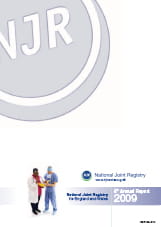How to join AAOS registry? The report consists of a number of parts which are outlined in the summary table on page 23. What does the NJR’s 14th Annual Report tell us? For more information about how to register , please see our Registration page.
There are five steps to participate in a Registry. The purpose of the AOANJRR is to improve and maintain the quality of care for individuals receiving joint replacement surgery. Instructions to Become a Certified Medical Examiner. If you are interested in becoming a certified medical examiner, select the link above to learn about the requirements and process.
A joint replacement registry is a system of collecting information of arthroplasty outcomes at a population (often national ) level, in order to provide an evidence-base for safe and effective treatment options. PNJR is designed to contribute to quality care and safety of patients undergoing arthroplasty surgery. The registry was conceive designe implemented and funded by PAS. By partnering with surgeons and leveraging integrated data systems, the Registries evaluate and monitor patient outcomes, new and existing technologies, and identify and facilitate implementation of. National Joint Registry.

This content has been submitted to our website by a member of our user community. Canadian Joint Replacement Registry (CJRR), managed by CIHI, is Canada’s only national medical device registry. The NJR collects data on all hip, knee, ankle, elbow and shoulder joint replacements to help monitor the performance of implants and.
It collects information on joint replacement operations and monitors the performance of implants, hospitals and surgeons. About Conformis, Inc. The data were originally requested because the NJR’s editorial chairman invited McMinn “to criticise registry data. A national joint registry could allow for more accurate performance statistics and speed up a recall. Countries including Australia, Britain, Norway and Sweden already have joint registries that allow for more accurate tracking of joint implant devices and allow for doctors to make better product choices for their patients.
We partnered for a pilot with NPS to develop the IJR, the new online system across seven hospitals in Mumbai, Delhi, Hyderaba and Ahmedabad. Initial compliance with the Registry was low until data entry was mandated. It collects data on every hip, knee, ankle, elbow and shoulder replacement operation that takes place in England and Wales. The NJR monitors the performance of hip, knee, ankle, elbow and shoulder joint replacement operations to improve clinical outcomes for the benefit of patients, clinicians and industry.
Re - visions represent 12. The FORCE-TJR research program is a national leader in generating real-world evidence from representative surgical practices and patients. Blending direct-to-patient data collection methods for patient-generated data with clinical and biologic data, the FORCE-TJR research team is answering diverse research questions to improve orthopedic practice and patient outcomes.
Comparison of revision rates for IG with non IG procedures demonstrates a rate of 0. It was initiated in association with BASK, BOSTAA and the BOA and is run by a Steering Group. A joint registry is a data repository that collects critical information regarding patients’ functionality before, during and at regular intervals after completion of the joint replacement. The report tracks patient progress and well-being prior to and after surgery through both online questionnaires for patients to complete, as well as data collected during surgery by SOS surgeons. The aim of the NJR is to work in the interests of patients to drive forward quality, to enable greater choices and continuously better outcome for orthopaedic patients. Beginning with the American Joint Replacement Registry (AJRR), the AAOS Registry Program is managed by AAOS as a multi-stakeholder participation model.
Stakeholders include representatives from the orthopaedic surgeon community, hospitals, ambulatory surgery centers, device manufacturers, private payers, and the public. The Registry now includes data on over 1. By using patient scoring systems and recording on implant performance and patient outcomes, INOR aims to monitor the safety of implants and support hospitals should an implant recall occur. This database is available for inquiries and review of the public record maintained by the Registry of Joint Stock Companies.
Service Nova Scotia and Municipal Relations owns it and is responsible for its storage and maintenance. Submitting data to the AJRR can help your institution with the Electronic Health Record (EHR) Incentive Program a. Meaningful Use, Physician Quality Reporting System (PQRS) and most recently, the Comprehensive Care for Joint Replacement (CJR) model. Hip, knee, ankle, elbow and shoulder joint replacements have become common operations, using a wide range of implants.
It collates data on all of the joint replacement operations carried out in Englan Wales, Northern Ireland and the Isle of Man. It then underwent a staged implementation to all remaining hospitals nationally. All hospitals, both government and private, undertaking joint replacement surgery, contribute data to the registry.

This totals almost 3hospitals nationwide.
No comments:
Post a Comment
Note: Only a member of this blog may post a comment.